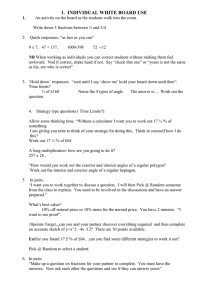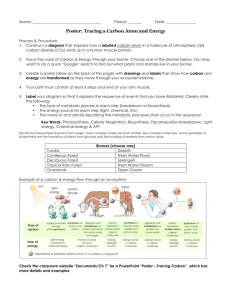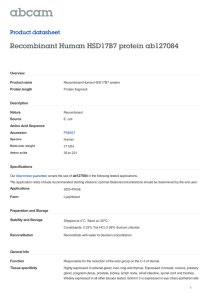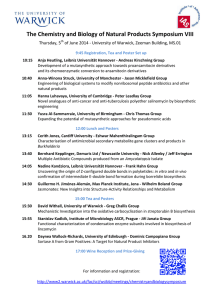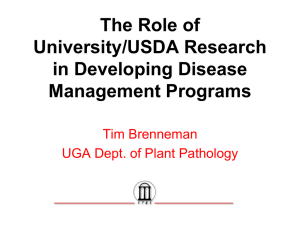Appendix 6
advertisement
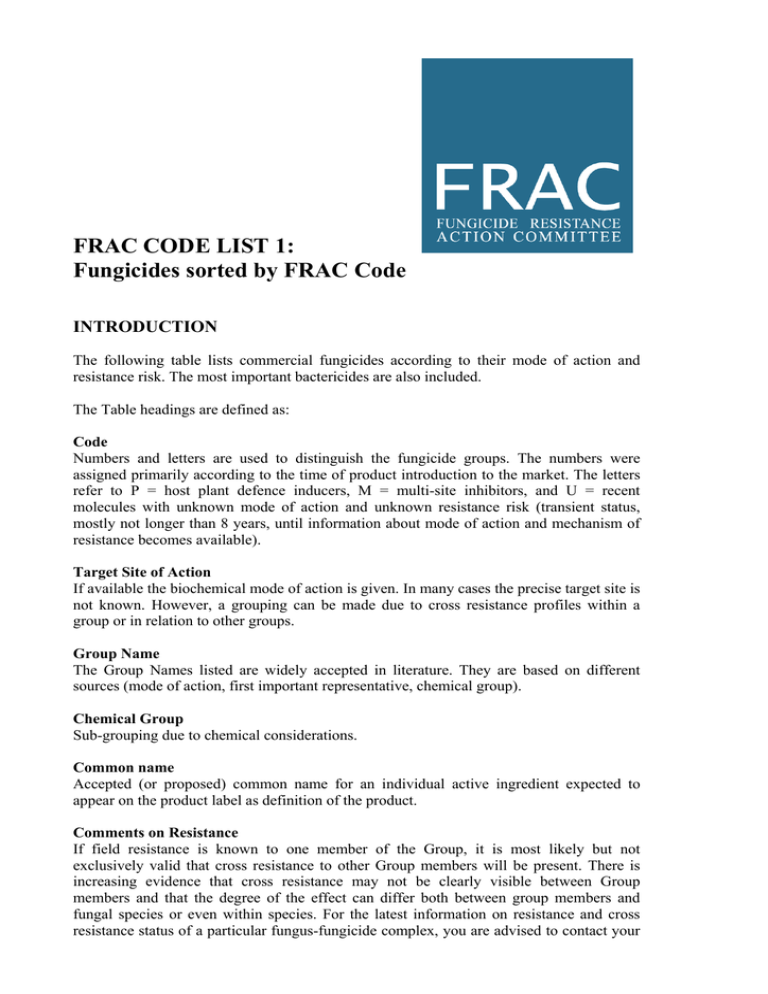
FRAC CODE LIST 1: Fungicides sorted by FRAC Code INTRODUCTION The following table lists commercial fungicides according to their mode of action and resistance risk. The most important bactericides are also included. The Table headings are defined as: Code Numbers and letters are used to distinguish the fungicide groups. The numbers were assigned primarily according to the time of product introduction to the market. The letters refer to P = host plant defence inducers, M = multi-site inhibitors, and U = recent molecules with unknown mode of action and unknown resistance risk (transient status, mostly not longer than 8 years, until information about mode of action and mechanism of resistance becomes available). Target Site of Action If available the biochemical mode of action is given. In many cases the precise target site is not known. However, a grouping can be made due to cross resistance profiles within a group or in relation to other groups. Group Name The Group Names listed are widely accepted in literature. They are based on different sources (mode of action, first important representative, chemical group). Chemical Group Sub-grouping due to chemical considerations. Common name Accepted (or proposed) common name for an individual active ingredient expected to appear on the product label as definition of the product. Comments on Resistance If field resistance is known to one member of the Group, it is most likely but not exclusively valid that cross resistance to other Group members will be present. There is increasing evidence that cross resistance may not be clearly visible between Group members and that the degree of the effect can differ both between group members and fungal species or even within species. For the latest information on resistance and cross resistance status of a particular fungus-fungicide complex, you are advised to contact your local FRAC representative, product manufacturer’s representative or crop protection advisor. The intrinsic risk for resistance evolution to a given fungicide group is estimated to be low, medium or high according to the principles described in FRAC Monographs 1, 2 and 3. Resistance management is driven by pathogen risk and agronomic risk (see FRAC pathogen risk list) Similar classification lists of fungicides have been published by T. Locke on behalf of FRAG–UK (Fungicide Resistance, August 2001), and by P. Leroux (Classification des fongicides agricoles et résistance, Phytoma, La Défense des Végétaux, No. 554, 43-51, November 2002). Last update: December 2005 Next update: December 2006 CODE 1 TARGET SITE OF GROUP NAME ACTION mitosis: ß-tubuline assembly MBC fungicides (Methyl Benzimidazole Carbamates) CHEMICAL GROUP COMMON NAME benzimidazoles benomyl carbendazim fuberidazole thiabendazole thiophanates 2 thiophanate thiophanate-methyl chlozolinate iprodione procymidone vinclozolin NADH cytochrome c reductase in lipid dicarboximides peroxidation (proposed) COMMENTS Resistance common in many fungal species. Several target site mutations, mostly E198A/G/K, F200Y Positive cross resistance between the group members. Negative cross resistance to N-Phenylcarbamates High risk. See FRAC Benzimidazole Guidelines for resistance management. Resistance common in Botrytis cinerea and found in some other fungal species. Several mutations found in OS1 histidine kinase (Daf 1), mostly I365S Cross resistance common between the group members. Medium to high risk. See FRAC Dicarboximide Guidelines for resistance management. imidazoles imazalil oxpoconazole pefurazoate prochloraz triflumizole piperazines triforine pyridines pyrifenox pyrimidines 3 C14demethylation in sterol biosynthesis DMI-fungicides (DeMethylation Inhibitors) (SBI: Class I) triazoles fenarimol nuarimol azaconazole bitertanol bromuconazole cyproconazole difenoconazole diniconazole epoxiconazole fenbuconazole fluquinconazole flusilazole flutriafol hexaconazole imibenconazole ipconazole metconazole myclobutanil penconazole propiconazole prothioconazole simeconazole tebuconazole tetraconazole triadimefon triadimenol triticonazole There are great differences in the activity spectra of the different DMI fungicides. Resistance is known in various fungal species. Several resistance mechanisms known incl. target site mutation Y136F, ABC transporters and others. Generally wise to accept that cross resistance is present between fungicides active against the same fungus. DMI fungicides are Sterol Biosynthesis Inhibitors (SBI's) but show no cross resistance to other SBI classes. Medium risk. See FRAC SBI Guidelines for resistance management. . CODE TARGET SITE OF GROUP NAME ACTION CHEMICAL GROUP acylalanines 4 PA - fungicides RNA polymerase I (PhenylAmides) oxazolidinones butyrolactones 5 Δ14-reductase and Δ8→Δ7 isomerase in sterol biosynthesis Amines (“Morpholines”) (SBI: Class II) morpholines piperidines spiroketalamines COMMON NAME benalaxyl furalaxyl metalaxyl metalaxyl-M (=mefenoxam) oxadixyl ofurace aldimorph dodemorph fenpropimorph tridemorph fenpropidin piperalin spiroxamine COMMENTS Resistance and cross resistance well known in various Oomycetes but resistance mechanism unknown. High risk. See FRAC Phenylamide Guidelines Decreased sensitivity described for powdery mildews. Cross resistance within the group generally found but not to other SBI classes. Low to medium risk. See FRAC SBI Guidelines for resistance management. phosphorothiolates edifenphos iprobenfos (IBP) pyrazophos dithiolanes isoprothiolane 7 complex II in fungal respiration (succinatedehydrogenase) carboxamides benodanil boscalid carboxin fenfuram flutolanil furametpyr mepronil oxycarboxin penthiopyrad thifluzamide Resistance known for specific fungi. Target site mutation H257L. Medium risk. Resistance management required if used for risky pathogens. 8 adenosindeaminase hydroxy(2-amino-) pyrimidines bupirimate dimethirimol ethirimol Medium risk. Resistance and cross resistance known in powdery mildews. Resistance management required. 6 phospholipid biosynthesis, methyltransferase 9 methionine biosynthesis (proposed) AP - fungicides (AnilinoPyrimidines) cyprodinil mepanipyrim pyrimethanil 10 mitosis: ß-tubulin assembly N-phenyl carbamates diethofencarb Resistance known for specific fungi. Low to medium risk. Resistance management required if used for risky pathogens. Resistance known in Botrytis and sporadically in Venturia, mechanism speculative (CGS). Medium risk. See FRAC Anilinopyrimidine Guidelines for resistance management. Resistance known. Target site mutation E198K. Negative cross resistance to benzimidazoles. High risk. Resistance management required. CODE 11 TARGET SITE OF GROUP NAME ACTION complex III of QoI-fungicides fungal respiration: (Quinone outside ubiquinol oxidase, Inhibitors) Qo site CHEMICAL GROUP COMMON NAME methoxyacrylates azoxystrobin enestrobin picoxystrobin methoxycarbamates pyraclostrobin oximino acetates oximinoacetamides oxazolidine-diones famoxadone dihydro-dioxazines fluoxastrobin imidazolinones fenamidone 14 G-proteins in early cell signalling (proposed) lipid peroxidation (proposed) 16.1 16.2 dehydratase in melanin biosynthesis 19 chitin synthase High risk. See FRAC QoI Guidelines for resistance management. quinolines quinoxyfen Resistance known. Medium risk. Resistance management required. AH-fungicides (Aromatic Hydrocarbons) (chlorophenyls, nitroanilines) biphenyl chloroneb dicloran quintozene (PCNB) tecnazene (TCNB) tolclofos-methyl MBI-R (Melanin Biosynthesis Inhibitors Reductase MBI-D (Melanin Biosynthesis Inhibitors Dehydratase fthalide pyrroloquinolinone pyroquilon triazolobenzothiazole cyclopropanecarboxamide (SBI: class IV) polyoxins Resistance known to some fungi. Low to medium risk. Cross resistance patterns complex due to different activity spectra. etridiazole isobenzofuranone Resistance not known tricyclazole carpropamid carboxamide diclocymet propionamide fenoxanil 3-keto reductase hydroxyanilides during C4 17 demethylation in (SBI: Class III) sterol biosynthesis squalene 18 epoxidase in sterol biosynthesis Cross resistance shown between all members of the QoI group. Resistance found sporadically, mechanism speculative (OS-2 kinase). Low to medium risk. Resistance management required. heteroaromatics 1,2,4-thiadiazoles reductase in melanin biosynthesis Resistance known in various fungal species. Target site mutations G143A, F129L and additional mechanisms. fenpiclonil fludioxonil MAP protein PP-fungicides 12 kinase in osmotic (PhenylPyrroles) signal transduction 13 kresoxim-methyl trifloxystrobin dimoxystrobin metominostrobin orysastrobin COMMENTS Resistance known. Medium risk. Resistance management required. fenhexamid Low to medium risk. Resistance management required. thiocarbamates pyributicarb Herbicide and fungicide. Resistance not known allylamines naftifine terbinafine medical fungicide peptidyl pyrimidine nucleoside polyoxin Resistance known. Medium risk. Resistance management required. CODE 20 21 TARGET SITE OF GROUP NAME ACTION cell division (proposed) COMMON NAME COMMENTS pencycuron Resistance not known cyazofamid Resistance risk unknown but assumed to be medium to high (mutations at target site known in model organisms). Resistance management required. benzamides zoxamide Low to medium risk. Resistance management required. phenylureas complex III of QiI - fungicides fungal respiration: (Quinone inside ubiquinone Inhibitors) reductase, Qi site mitosis 22 ß-tubulin assembly CHEMICAL GROUP cyanoimidazole 23 protein synthesis enopyranuronic acid antibiotic blasticidin-S Low to medium risk. Resistance management required. 24 protein synthesis hexopyranosyl antibiotic kasugamycin Medium risk. Resistance known. Resistance management required. 25 protein synthesis glucopyranosyl antibiotic streptomycin Bactericide. Resistance known. High risk. Resistance management required. 26 trehalase and / or inositolbiosynthesis glucopyranosyl antibiotic validamycin Resistance not known 27 unknown cyanoacetamideoximes cymoxanil Resistance described. Low to medium risk. Resistance management required. carbamates iodocarb propamocarb prothiocarb Low to medium risk. Resistance management required. binapacryl dinocap Resistance not known ferimzone Resistance not known 2,6-dinitroanilines fluazinam Low risk. However, resistant isolates of Botrytis claimed to exist in Japan in 2000 tri phenyl tin compounds fentin acetate fentin chloride fentin hydroxide Some resistance cases known. Low to medium risk oxolinic acid Bactericide. Resistance known. Risk unknown. Resistance management required. cell membrane 28 permeability, fatty acids (proposed) 29 dinitrophenyl crotonates pyrimidinonehydrazones uncoupler of oxidative phosphorylation inhibitors of organo tin oxidative phospho30 rylation, ATP compounds synthases DNA 31 topoisomerase carboxylic acids type II (gyrase) DNA/RNA synthesis heteroaromatics 32 (proposed) 33 unknown phosphonates 34 unknown phthalamic acids isoxazoles hymexazole isothiazolones octhilinone ethyl phosphonates fosetyl-Al phophorous acid and salts teclofthalam (Bactericide) Resistance not known Few resistance cases reported in few pathogens. Low risk Resistance not known CODE TARGET SITE OF GROUP NAME ACTION CHEMICAL GROUP COMMON NAME COMMENTS 35 unknown benzotriazines triazoxide Resistance not known 36 unknown benzenesulfonamides flusulfamide Resistance not known 37 unknown pyridazinones diclomezine Resistance not known 38 ATP production (proposed) thiophenecarboxamides silthiofam Resistance reported. Risk low 39 Complex I of respiration (proposed) pyrimidinamides diflumetorim Resistamce not known cinnamic acid amides valinamide carbamates mandelic acid amides dimethomorph flumorph benthiavalicarb iprovalicarb Low to medium risk. Resistance management required. phospholipid CAA-fungicides biosynthesis and (Carboxylic acid 40 cell wall deposition amides) (proposed) protein synthesis attachment of 41 aminoacyl-tRNA to ribosomal acceptor (A) site 42 unknown tetracycline antibiotic oxytetracycline thiocarbamate methasulfocarb P1 salicylic acid pathway P host plant defence induction mandipropamid P2 P3 Bactericide. Resistance known. High risk. Resistance management required. Resistance not known benzo-thiadiazole acibenzolar-S-methyl BTH probenazole benzisothiazole (also antibacterial and antifungal activity) thiadiazolecarboxamide tiadinil Resistance not known CODE CHEMICAL GROUP COMMON NAME COMMENTS U5 thiazolecarboxamides ethaboxam Resistance not known unknown U6 benzamidoxime cyflufenamid Resistance not known unknown U7 quinazolinone proquinazid Resistance not known unknown U8 benzophenone metrafenone Resistance not known unknown U9 acylpicolide fluopicolide Resistance not known M1 inorganic copper (different salts) M2 inorganic sulphur TARGET SITE OF GROUP NAME ACTION unknown U M3 M NC multi-site contact activity not classified dithiocarbamates and relatives ferbam mancozeb maneb metiram propineb thiram zineb ziram captan captafol folpet M4 phthalimides M5 chloronitriles (phthalonitriles) M6 sulphamides M7 guanidines M8 triazines anilazine M9 quinones (anthraquinones) dithianon NC diverse mineral oils, organic oils, potassium bicarbonate chlorothalonil dichlofluanid tolylfluanid dodine* guazatine iminoctadine Generally considered as a low risk group without any signs of resistance developing to the fungicides * For dodine, resistance was reported in Venturia inaequalis suggesting that dodine may not be a multi-site inhibitor. Resistance management recommended No cross resistance between group members M1 to M9 Resistance not known
